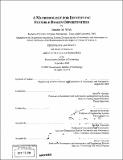A methodology for identifying flexible design opportunities
Author(s)
Wilds, Jennifer M
DownloadFull printable version (26.31Mb)
Other Contributors
Massachusetts Institute of Technology. Technology and Policy Program.
Advisor
Daniel E. Hastings and Richard de Neufville.
Terms of use
Metadata
Show full item recordAbstract
Technical and operational uncertainties dynamically change environments for engineering systems. Flexibility allows systems to continue delivering value as the uncertainty unfolds. Uncertainty can better be managed by embedding flexibility into the system. However, system designers do not have a tool or metric that identifies which components within the system to focus embedded flexibility efforts. They rely on intuition developed through experience and expertise to build in system flexibility, often leading to disagreement between system stakeholders (both designers and customers) about where to focus efforts due to the differing perspectives and inability to assess knock-on effects. Therefore, providing a tool to help designers screen the system for opportunities for embedded flexibility will also establish reasoning supporting their claims.This thesis proposes a general screening methodology for identifying potential Flexible Design Opportunities (FDOs) in systems; demonstrates the methodology using a Micro Air Vehicle (MAV) platform developed for Department of Defense (DoD); evaluates the ability to exploit FDOs within DoD Acquisitions; and makes recommendations to system designers using the presented case, where the question of where and how to embed flexibility is complicated by multiple system uncertainties. The case study provides useful results, identifying FDOs that were validated by the author's experience as a system engineer and program manager. The development of the methodology yielded two characteristics to screen system components for FDOs: the component's ability to propagate or absorb change and its switch cost associated with making the desired change. Change Propagation Analysis coupled with filtering techniques to reduce the complexity of the data and rank system components with respect a newly proposed metric, Desired Flexibility Score (DFS), that represents the attractiveness of the component for embedded flexibility. The analysis concludes that the DoD acquisitions guidelines do provide opportunities to implement FDOs for longer term programs (> five years). However, process requirements may hinder the ability to react quickly to rapidly changing or emerging technical and operational uncertainties to maximize the upside potential of systems, while minimizing the downside risk.
Description
Thesis (S.M.)--Massachusetts Institute of Technology, Dept. of Aeronautics and Astronautics; and, (S.M.)--Massachusetts Institute of Technology, Engineering Systems Division, Technology and Policy Program, 2008. Includes bibliographical references (p. 105-109).
Date issued
2008Department
Massachusetts Institute of Technology. Department of Aeronautics and Astronautics; Massachusetts Institute of Technology. Engineering Systems Division; Technology and Policy ProgramPublisher
Massachusetts Institute of Technology
Keywords
Aeronautics and Astronautics., Technology and Policy Program.